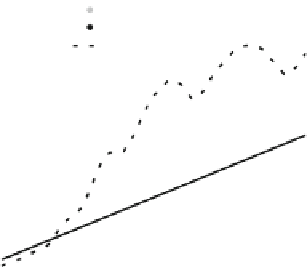Geoscience Reference
In-Depth Information
a (AU)
a (AU)
0.6
0.8
1.0
1.2
1.4
1.6
1.8
0.6
0.8
1.0
1.2
1.4
1.6
1.8
0.15
6
1 km
5 km
gas
5
t= 5680 yr
q
b
=0.500
e
b
=0.3
a
b
=10.0 AU
0.10
4
3
0.05
2
1
0
0.00
1-5 km
1-1 km
5-5 km
1-5 km
1-1 km
5-5 km
1500
1500
1000
1000
500
500
0
0
0.6
0.8
1.0
1.2
1.4
1.6
1.8
0
2000
4000
6000
r (AU)
t (yr)
Fig. 13.5
Planetesimal evolution in an
evolving
gas disc for a tight binary of separation 10 AU.
To p l e f t
: longitude of periastron, after 5,680 years, for 1 km planetesimals, for 5 km ones and for
the gas disc.
Top right
: orbital eccentricity.
Bottom left
: encounter velocities between planetesimals
as a function of their sizes.
Bottom right
: average encounter velocities at 1 AU as a function of time
(From Paardekooper et al.
2008
, courtery of MNRAS)
nevertheless shown that if the gas disc is very massive and almost axisymmetric, its
gravity could in fact reduce encounter velocities amongst planetesimals. However,
this massive axisymmetric disc prerequisite is probably not likely to be generic,
as all hydrodynamical studies of gas discs in binaries have shown that they reach
eccentricities that are at least one order of magnitude higher than the few 10
3
needed in the Rafikov (
2013
) model (Kley and Nelson
2007
; Marzari et al.
2009
,
2012
;Zsometal.
2011
; Müller and Kley
2012
).
On a more positive note, Xie and Zhou (
2008
) showed that during the late stages
when gas dissipates from the disc, the dispersal of planetesimal orbits narrows and
the systems can get accretion friendly again. However, this behaviour probably
occurs too late, once most planetesimals have already been either grounded to dust
or spiralled onto the star because of gas friction (Thebault et al.
2008
).






















































































































































































































































































































































































































































































































































































































































































































































































































































































































































































































































































































































































































































































































































































































































































































































































































































































































































































































































































































































































































































































































































































































































































































































































































































































































































































































































































































































































































































































































































































































































































































































































































































































































































































































































































































































































































































































































































































































































































































































































































































































































































































































































































































































































































































































































































































































































































































































































































































































































































































































































































































































































































































































































































































































































































































































































































































































































































































































































































































































































































































































































































































































































































































































































































































































































































































































































































































































































































































































































































































































































































































































































































































































































































































































































































































































































































































































































































































































































































































































































































































































































































































































































































































































































































































































































































































































































































































































































































































































































































































































































































































































































































































































































































































































































































































































































































































































































































































































































































































































































































































































































































































































































































































































































































































































































































































































































































































































































































































































































































































































































































































































































































































































































































































































































































































































































































































































































































































































































































































































































































































































































































































































































































































































































































































































































































































































































































































































































































































































































































































































































































































































































































































































































































































































































































































































































































































































































































































































































































































































































































































































































































































































































































































































































































































































































































































































































































































































































































































































































































































































































































































































































































































































































































































































































































































































































































































































































































































































































































































































































































































































































































































































































































































































































































































































































































































































































































































































































































































































































































































































































































































































































































































































































































Search WWH ::

Custom Search